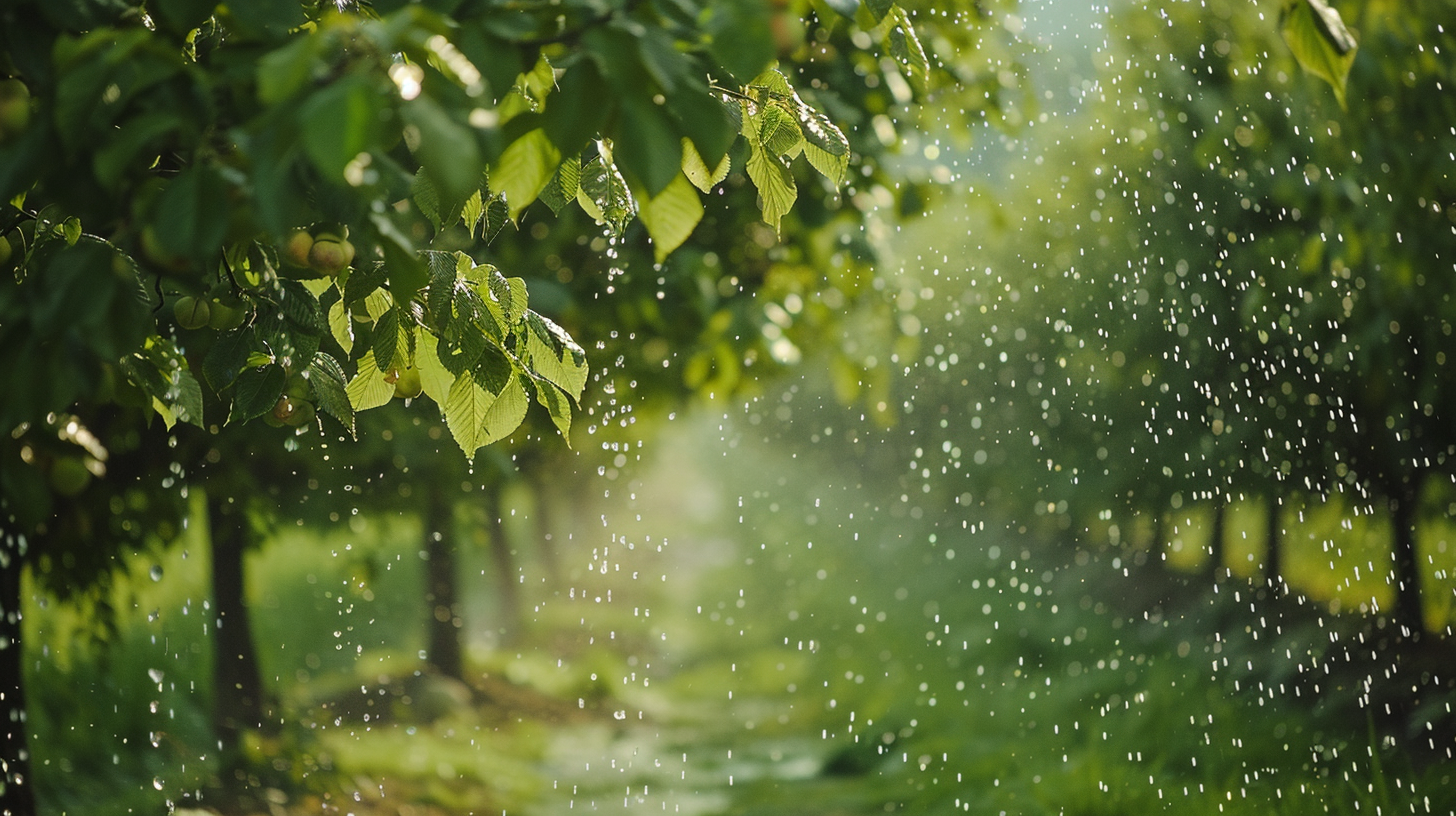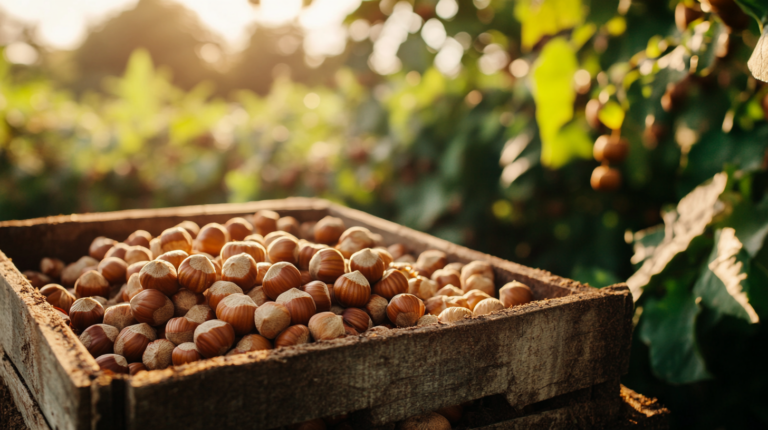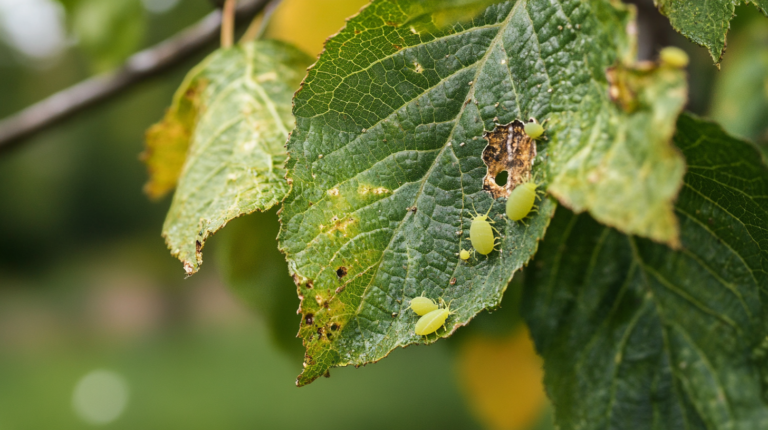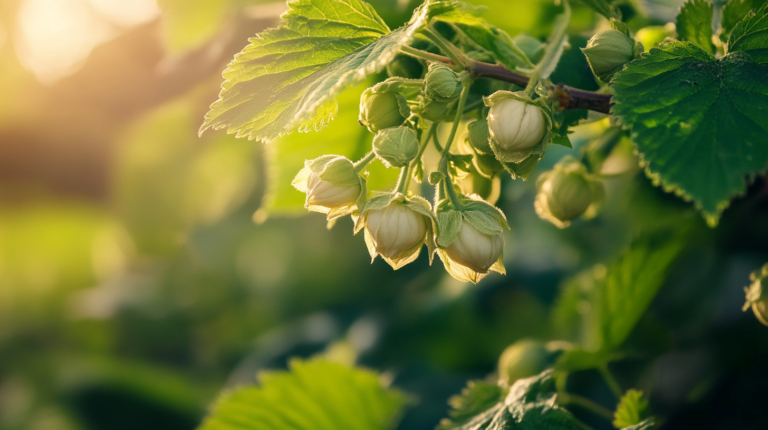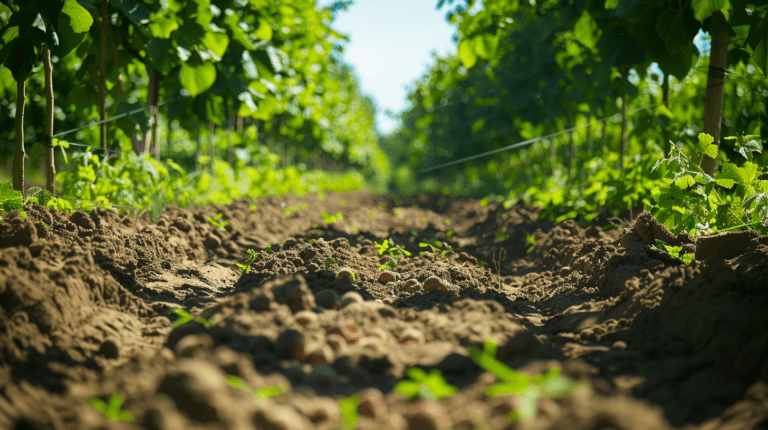The Basics of Watering Hazelnut Trees
Watering Hazelnut Trees Introduction
Proper watering is crucial for the healthy growth and productivity of hazelnut trees (Corylus avellana L.). Water is a vital component that influences every aspect of a tree’s development, from root establishment to nut production. Adequate irrigation ensures that hazelnut trees can absorb essential nutrients from the soil, maintain cellular functions, and withstand environmental stresses. Without sufficient water, trees can become susceptible to diseases, produce lower yields, and ultimately fail to thrive.
Several key factors influence the water needs of hazelnut trees. Climate plays a significant role, as trees in hot and dry regions require more frequent watering to compensate for higher evapotranspiration rates. Soil type also affects water retention and drainage, with well-drained soils being ideal for hazelnut cultivation. Additionally, the age of the tree is a critical consideration; young trees need more frequent watering compared to mature ones to support their rapid growth and root development. Understanding these factors is essential for developing an effective watering strategy that ensures the long-term health and productivity of hazelnut orchards.
By tailoring irrigation practices to the specific needs of your hazelnut trees, you can promote robust growth, enhance nut quality, and achieve optimal yields, making proper watering a cornerstone of successful hazelnut cultivation.
Understanding Water Requirements
Effective watering of hazelnut trees depends on understanding the specific water needs dictated by climate, soil type, and tree age. These factors significantly influence the amount and frequency of irrigation required to maintain healthy and productive trees.
Climate
Climate is a primary determinant of water requirements for hazelnut trees. In regions with hot and dry climates, trees experience higher rates of evapotranspiration, necessitating more frequent watering. The increased temperatures and dry conditions accelerate water loss from both the soil and the tree’s foliage, making consistent irrigation essential. Conversely, in cooler and more humid climates, the natural rainfall may suffice for part of the growing season, reducing the need for supplemental watering (Allen et al., 1998). Additionally, climate change is exacerbating these challenges, with rising temperatures and altered precipitation patterns further increasing water demands for hazelnut trees (Jones et al., 2012).
Soil Type
Soil type is another critical factor influencing the water needs of hazelnut trees. Well-drained soils, such as sandy loams, are ideal for hazelnut cultivation as they allow excess water to drain away, preventing root rot and other waterlogged-related issues. However, these soils also require more frequent irrigation since they do not retain moisture as effectively as heavier clay soils. On the other hand, clay soils hold water longer but can lead to poor drainage and aeration, which may suffocate roots if not managed properly (Brady & Weil, 2008). Regular monitoring of soil moisture content is essential to balance these properties and ensure optimal water availability for the trees.
Tree Age
The age of the hazelnut tree also dictates its watering requirements. Young trees, particularly in the establishment phase, need frequent and consistent watering to support their rapid growth and root development. These trees have shallower root systems that are less capable of accessing deep soil moisture, making regular irrigation vital (Hart et al., 2013). In contrast, mature trees have more extensive root systems that can tap into deeper water reserves, allowing them to withstand longer periods between waterings. Nonetheless, mature trees still require adequate watering, especially during critical growth phases like flowering and nut development to ensure high yields and nut quality.
By considering climate, soil type, and tree age, growers can tailor their irrigation practices to meet the specific needs of their hazelnut trees, promoting healthy growth and maximizing productivity.
Monitoring and Adjusting Watering
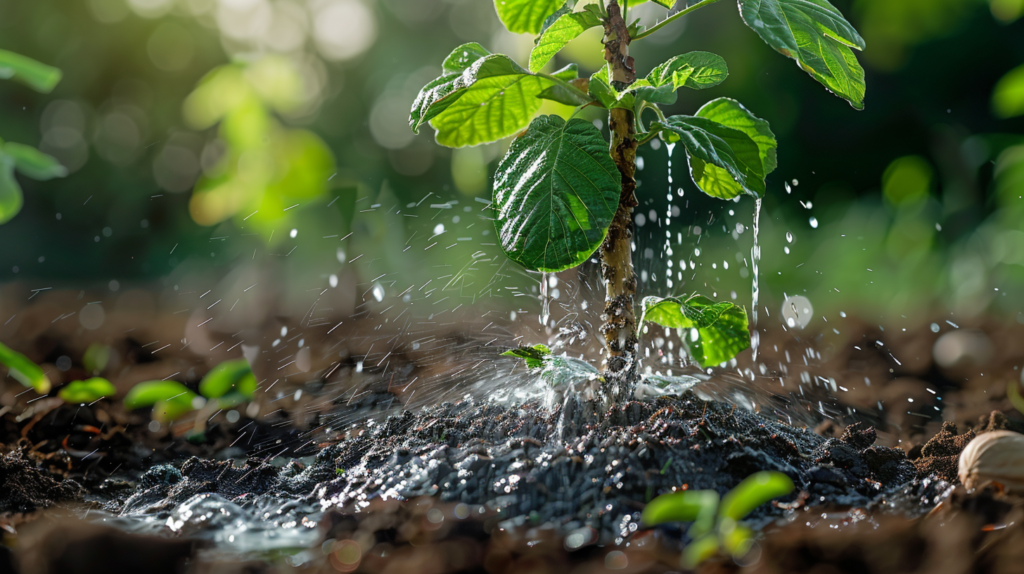
To ensure hazelnut trees receive the right amount of water, it is crucial to monitor and adjust watering practices regularly. Key methods for assessing tree water status include measuring soil moisture, leaf water potential, and stomatal conductance.
Soil Moisture
Monitoring soil moisture is fundamental for maintaining appropriate irrigation levels. Using soil moisture probes or sensors can provide accurate readings of water content at various soil depths. These tools measure the volumetric water content and help determine whether the soil within the root zone is sufficiently moist (Decagon Devices, 2011). Regular measurements at different depths (e.g., 0-30 cm, 30-60 cm) ensure that the water reaches the entire root system, particularly during critical growth stages such as flowering and nut filling. Consistent soil moisture levels prevent stress conditions caused by either drought or waterlogging, promoting healthy tree growth and optimal nut production.
Leaf Water Potential and Stomatal Conductance
Leaf water potential is a direct indicator of the water status within the plant. Measured using a pressure chamber or psychrometer, it reflects the energy required to extract water from the leaves, with more negative values indicating higher water stress (Turner, 1988). Regular monitoring of leaf water potential helps in determining the effectiveness of irrigation practices and adjusting them as necessary to ensure trees are adequately hydrated.
Stomatal conductance, measured with a porometer, indicates how open or closed the stomata are, reflecting the tree’s water use efficiency and response to environmental conditions (Jones, 1998). High stomatal conductance values suggest good water availability, while low values indicate water stress. By monitoring stomatal conductance, growers can adjust irrigation schedules to align with the trees’ physiological needs, optimizing water use and preventing over- or under-watering.
Integrating these monitoring techniques allows for precise adjustments to irrigation practices, ensuring hazelnut trees receive optimal water throughout their growth cycle. This proactive approach not only supports tree health and productivity but also enhances water use efficiency, crucial in regions where water resources are limited.
Seasonal Considerations
Watering needs for hazelnut trees vary significantly throughout the growing season. Understanding these seasonal variations is essential for optimizing irrigation practices and ensuring healthy, productive trees.
Spring
In spring, as hazelnut trees emerge from dormancy, their water requirements increase to support new growth. During this period, trees develop new leaves and flowers, which are crucial for the upcoming nut production. Consistent watering is vital to facilitate this growth phase and ensure that the trees have sufficient moisture to develop strong, healthy structures (Oregon State University Extension Service, 2011). Adequate water availability during spring can also help mitigate the risk of late frosts damaging the tender new growth.
Summer
Summer is the peak period for water demand due to high temperatures and increased evapotranspiration rates. Hazelnut trees require more frequent and substantial watering during this season to maintain soil moisture levels and support the development and filling of nuts (Fulton et al., 2010). Inadequate watering during summer can lead to water stress, which may reduce nut size and quality, and increase susceptibility to pests and diseases. Mulching can be particularly beneficial in summer to retain soil moisture and moderate soil temperatures. It is crucial to monitor soil moisture regularly and adjust irrigation practices to ensure that the root zone remains adequately moist.
Fall
As fall approaches, hazelnut trees begin to prepare for dormancy, and their water needs gradually decrease. During this period, reducing watering helps the trees harden off and transition smoothly into dormancy. Overwatering in fall can lead to waterlogged soils, which may cause root rot and other issues during the dormant season (Mehlich et al., 2017). However, it is still important to provide sufficient moisture to support the final stages of nut maturation and to prevent stress-related damage. Gradually tapering off irrigation allows the trees to acclimate to the cooler, wetter conditions of fall and winter.
By adjusting watering practices to align with the seasonal needs of hazelnut trees, growers can ensure that their trees receive optimal care throughout the year. This proactive approach supports robust growth, high-quality nut production, and overall tree health.
Mulching
Mulching is a beneficial practice in hazelnut cultivation, offering numerous advantages that contribute to tree health and productivity. Understanding the benefits, types, and application techniques of mulch can help growers maximize these advantages.
Benefits of Mulching
Mulching provides several key benefits for hazelnut trees. Firstly, it helps retain soil moisture by reducing evaporation, ensuring that the roots have a consistent water supply (Chalker-Scott, 2007). This is particularly important during dry periods and in regions with high evapotranspiration rates. Secondly, mulch moderates soil temperature, keeping the soil cooler in summer and warmer in winter, which can protect the root system from extreme temperature fluctuations (Goh et al., 2013). Additionally, mulching suppresses weed growth, reducing competition for water and nutrients. Organic mulches also contribute to soil fertility as they decompose, enriching the soil with organic matter and promoting beneficial microbial activity (Rathore et al., 1998).
Types of Mulch
There are various types of mulch suitable for hazelnut trees, each with its own set of benefits:
- Organic Mulch: Includes materials such as straw, wood chips, bark, compost, and leaves. These mulches decompose over time, adding organic matter to the soil and improving soil structure and fertility (Neilsen et al., 2003).
- Inorganic Mulch: Includes materials like plastic sheeting, landscape fabric, and gravel. These mulches do not decompose and are primarily used for moisture retention and weed suppression. However, they do not improve soil fertility (Lamont, 2005).
Application Techniques
Proper application of mulch is crucial for its effectiveness. When applying organic mulch, spread a layer 2-4 inches thick around the base of the hazelnut trees, extending out to the drip line but keeping it a few inches away from the trunk to prevent moisture buildup and potential rot (University of Minnesota Extension, 2021). For inorganic mulch, ensure that the material is securely placed to prevent shifting and exposure of the soil. In both cases, avoid piling mulch too deeply, which can create a barrier to water and air movement and potentially harm the roots.
Reapply mulch as necessary, especially organic types, which decompose over time. Regularly check the mulch layer to maintain its thickness and effectiveness, ensuring continued benefits for your hazelnut trees.
By selecting the appropriate type of mulch and applying it correctly, growers can significantly enhance water retention, soil health, and overall tree performance.
Water Quality
Ensuring the quality of water used for irrigating hazelnut trees is crucial for the health and productivity of the orchard. Water quality affects the soil, the trees, and ultimately, the yield and quality of the nuts produced.
Importance of Water Quality
High-quality water is essential for hazelnut trees to thrive. Contaminants such as salts, heavy metals, and pathogens can have detrimental effects on tree health and soil quality (Bauder et al., 2011). Excessive salts in irrigation water can lead to soil salinization, which impairs root function and reduces the tree’s ability to absorb water and nutrients (Grattan & Grieve, 1999). This can result in stunted growth, leaf burn, and lower yields. Additionally, waterborne pathogens can cause diseases that weaken or kill hazelnut trees, while heavy metals can accumulate in the soil and become toxic to plants over time. Ensuring that the water used is clean and free from harmful substances is therefore critical for maintaining a healthy orchard.
Testing and Maintaining Water Quality
Regular testing of irrigation water is essential to identify any potential issues and take corrective actions. Water quality tests should measure parameters such as pH, electrical conductivity (EC), total dissolved solids (TDS), and concentrations of specific ions like sodium, chloride, and boron (Ayers & Westcot, 1985). These tests can be conducted through local agricultural extension services, commercial laboratories, or using portable water testing kits.
Maintaining water quality involves several strategies. If high salinity is detected, implementing practices such as leaching, which involves applying extra water to flush salts from the root zone, can be beneficial (Maas & Grattan, 1999). Additionally, using gypsum to improve soil structure and enhance salt leaching may be effective. For heavy metals and other contaminants, treatment options like filtration and chemical amendments can be employed to reduce their concentrations.
Growers should also be mindful of the source of their irrigation water. Surface water sources such as rivers and lakes may be more prone to contamination compared to groundwater sources. Implementing measures to protect water sources from contamination, such as proper waste disposal and managing runoff, can help maintain the quality of irrigation water.
By regularly testing and maintaining high water quality, hazelnut growers can protect their orchards from the adverse effects of contaminants, ensuring the trees remain healthy and productive.
Conclusion
Proper watering is essential for the healthy growth and productivity of hazelnut trees. Understanding the specific water requirements influenced by climate, soil type, and tree age helps in tailoring effective irrigation strategies. Employing methods such as drip, sprinkler, or manual watering, coupled with regular monitoring of soil moisture and physiological indicators like leaf water potential and stomatal conductance, ensures that trees receive adequate hydration. Seasonal adjustments in watering practices cater to the changing needs of the trees throughout the growing season, while mulching aids in moisture retention and temperature regulation. Additionally, maintaining high water quality through regular testing and corrective measures prevents potential harm from contaminants.
Adhering to these guidelines not only promotes robust growth and high-quality nut production but also enhances the overall health and resilience of hazelnut orchards. By implementing these best practices, growers can optimize water use, protect their trees from stress and diseases, and achieve sustainable, productive cultivation. Proper watering is a cornerstone of successful hazelnut farming, ensuring that trees thrive and yield bountifully year after year.
References
- Ayers, R. S., & Westcot, D. W. (1985). Water quality for agriculture. FAO Irrigation and Drainage Paper 29 Rev. 1. FAO.
- Bauder, T. A., Waskom, R. M., Sutherland, P. L., & Davis, J. G. (2011). Irrigation Water Quality Criteria. Colorado State University Extension.
- Brady, N. C., & Weil, R. R. (2008). The Nature and Properties of Soils (14th ed.). Pearson.
- Chalker-Scott, L. (2007). Impact of mulches on landscape plants and the environment – A review. Journal of Environmental Horticulture, 25(4), 239-249.
- Decagon Devices. (2011). Measuring Soil Moisture for Irrigation Water Management. Decagon Devices, Inc.
- Fulton, A. E., Buchner, R. P., Olson, B., & Schwankl, L. J. (2010). Using the Pressure Chamber for Irrigation Management in Walnut, Almond, and Prune. University of California Agriculture and Natural Resources.
- Goh, K. M., Pearson, A., & Morton, J. D. (2013). Effects of organic and non-organic mulches on soil properties and production of ‘Hayward’ kiwifruit (Actinidia deliciosa). New Zealand Journal of Crop and Horticultural Science, 41(1), 24-33.
- Grattan, S. R., & Grieve, C. M. (1999). Salinity–mineral nutrient relations in horticultural crops. Scientia Horticulturae, 78(1-4), 127-157.
- Hart, J. M., Sullivan, D. M., & Petrie, S. (2013). Hazelnuts. Pacific Northwest Extension Publication PNW 689. Oregon State University.
- Jones, H. G. (1998). Stomatal control of photosynthesis and transpiration. Journal of Experimental Botany, 49(Special Issue), 387-398.
- Jones, P. D., Harris, I., & Osborn, T. J. (2012). The impact of climate change on agriculture: Addressing the water management challenge. Environmental Research Letters, 7(4), 1-7.
- Lamont, W. J. (2005). Plastic Mulches for the Production of Vegetable Crops. HortTechnology, 15(3), 477-481.
- Maas, E. V., & Grattan, S. R. (1999). Crop yields as affected by salinity. In R. W. Skaggs & J. van Schilfgaarde (Eds.), Agricultural Drainage (Agronomy Monograph No. 38). ASA, CSSA, SSSA.
- Mehlich, A., Sims, J. T., & Murrmann, R. P. (2017). Leaf Analysis and Soil Testing for High-Yield Horticultural Crop Production. Elsevier.
- Neilsen, G. H., Hogue, E. J., Forge, T., & Neilsen, D. (2003). Mulches and Biosolids Affect Vigor, Yield, and Leaf Nutrition of Fertigated High Density Apple. HortScience, 38(1), 41-45.
- Oregon State University Extension Service. (2011). Growing Hazelnuts in the Pacific Northwest: Orchard Management. Oregon State University.
- Rathore, A. L., Pal, A. R., & Sahu, K. K. (1998). Tillage and mulching effects on water use, root growth, and yield of rainfed mustard and chickpea grown after lowland rice. Journal of the Science of Food and Agriculture, 78(2), 149-161.
- Turner, N. C. (1988). Measurement of plant water status by the pressure chamber technique. Irrigation Science, 9(4), 289-308.
- University of Minnesota Extension. (2021). Mulching and its Benefits. University of Minnesota.
